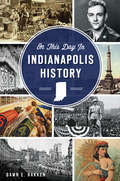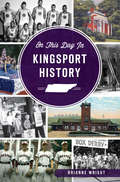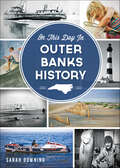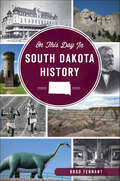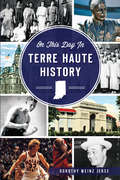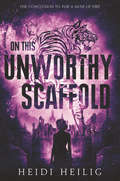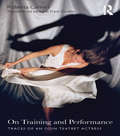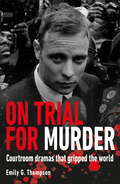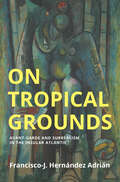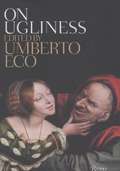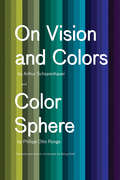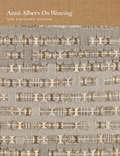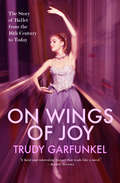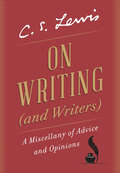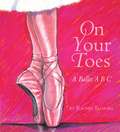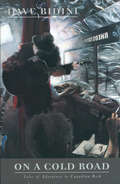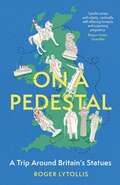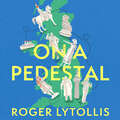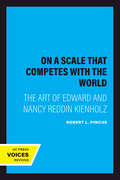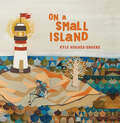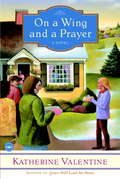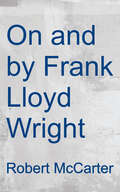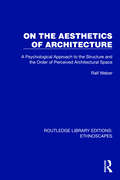- Table View
- List View
On This Day in Indianapolis History
by Dawn E. BakkenAlthough best known for "The Greatest Spectacle in Racing," Indianapolis claims countless fascinating stories that happened off the track--one for every date on the calendar. In a single day on January 1, 1970, Indianapolis jumped from the nation's twenty-sixth largest city to number eleven. On July 25, 1934, gangster and native son John Dillinger was laid to rest in Crown Hill Cemetery, where chips of his four successive gravestones became favorite city souvenirs. On September 17, 1945, the nation finally learned that Indianapolis was the top-secret manufacturing center for the Norden bombsight, crucial to Allied victory. And on September 6, 1959, jazz musician Wes Montgomery and his brothers finished recording one of their most popular albums. One day at a time, author Dawn Bakken chronicles a year of people, places and events in Circle City history.
On This Day in Kingsport History (On This Day In Ser.)
by Brianne WrightWith a story for each day of the year, Kingsport City archivist and author Brianne Wright illuminates the significant people, places and events of the Model City. Charley Grubb evaded his prison sentence when he slyly escaped from the courtroom during the jury deliberations on May 25, 1929. On June 5, 1936, the Rotherwood Bridge collapse nearly claimed five lives. After four decades, the State Theater officially aired its last film on March 26, 1978. The city's first "Fun Fest," held on August 8, 1981, aimed to bolster community unity. From its early days as Boatyard to the modern-day Kingsport, colorful characters and quirky events shaped the city's unique history one day at a time.
On This Day in Outer Banks History (On This Day In Ser.)
by Sarah DowningThe Outer Banks is much more than an idyllic vacation destination. A day at a time through history, it has claimed its place as a colorful region of the Old North State. Author and historian Sarah Downing offers a daily look at the quirky and fascinating stories from the region's four-hundred-year history. During a fierce hand-to-hand battle off Ocracoke Island on November 22, 1718, Lieutenant Robert Maynard killed the infamous pirate Blackbeard with five pistol shots and twenty sword cuts and slashes. On February 14, 1992, a sick seal caught a ride to safety on a Coast Guard patrol boat. Add a salty slice of history a day or a month at time with this celebration of Outer Banks heritage.
On This Day in South Dakota History (On This Day In)
by Brad TennantSouth Dakota is quietly nestled in the grasslands and Black Hills, but its history is far less hidden. One day at a time, author Brad Tennant presents intriguing, event-driven anecdotes of state history. On July 17, 1925, the state American Legion passed a resolution to initiate American Legion baseball. On April 29, 1930, Congress passed an act honoring the deceased chiefs of the Cheyenne River Sioux Tribe and the valiant men who made the supreme sacrifice in service in World War I. Celebrate an entire year of history in the Mount Rushmore State or enjoy it one day at a time.
On This Day in Terre Haute History
by Dorothy Weinz JerseOn the east bank of the Wabash River, Terre Haute was established as a real estate venture in 1816. Two hundred years of history is chronicled here, one day at a time, with stories of its remarkable events and colorful characters. In 1915, Coca-Cola introduced its iconic green bottle, designed and manufactured locally at Root Glass Company. Giving credit to the town's "Sin City" moniker, authorities seized the largest moonshine still ever discovered in Vigo County on July 15, 1929. Many notable Hoosiers have called Terre Haute home, too, including labor leader Eugene V. Debs and Tony Hulman of Indianapolis 500 fame. Every date on the calendar reveals a story to fascinate, educate or entertain.
On This Unworthy Scaffold
by Heidi HeiligJetta is in the center of a war. With her magical power, she could save everyone, save her country . . . or she could destroy it all. Heidi Heilig blends traditional storytelling with ephemera for a lush, page-turning commercial fantasy for fans of Tomi Adeyemi and Leigh Bardugo. The final book in the acclaimed Shadow Players trilogy. Jetta’s home is spiraling into civil war. Le Trépas—the deadly necromancer—has used his blood magic to wrest control of the country, and Jetta has been without treatment for her malheur for weeks. Meanwhile, Jetta’s love interest, brother, and friend are intent on infiltrating the palace to stop the Boy King and find Le Trépas to put an end to the unleashed chaos. The sweeping conclusion to Heidi Heilig’s ambitious trilogy takes us to new continents, introduces us to new gods, flings us into the middle of palace riots and political intrigue, and asks searching questions about power and corruption. Acclaimed author Heidi Heilig creates a rich world inspired by Southeast Asian cultures and French colonialism. Told from Jetta’s first-person point-of-view, as well as with chapters written as play scripts and ephemera such as songs, myths, and various forms of communication, On This Unworthy Scaffold is a satisfying finale to the epic fantasy trilogy. It will thrill readers who love Claire Legrand’s Furyborn, Laini Taylor’s Strange the Dreamer, and N. K. Jemisin’s The Fifth Season.
On Training and Performance: Traces of an Odin Teatret Actress
by Roberta Carreri"Outstanding … a technical manual (for actors and directors), an historical document of importance, and a volume that is a delight to read." Ian Watson, Rutgers "An extremely valuable personal account of Roberta Carreri’s process as an actor." Alison Hodge, Artistic Director, The Quick and the Dead "An excellent book with a unique voice." Ben Spatz, University of Huddersfield Roberta Carreri is one of acclaimed theatre company Odin Teatret's longest-serving actors, and the last to be trained by Eugenio Barba himself. In this book, she relives the milestones of her professional journey, including: her first experiences of street theatre the discovery of Asian performance traditions pedagogical activities and character creation encounters with artists and spectators the inception of her solo performances, Judith and Salt Interwoven with rich photographic documentation and a wealth of biographical information, this inspiring handbook reveals the professional secrets of an Odin Teatret actor as well as the story of a life of work, research, and passion.
On Trial For Murder
by DKUncover the dramatic events surrounding some of the world's most controversial murder trials.Explore the riveting twists and turns of some of the most notorious and controversial murder trials in history, such as the O. J. Simpson, Phil Spector and Oscar Pistorius cases. From arrests to vital evidence, trials to final verdicts – no stone is left unturned in these chilling and complete accounts of the cases that shocked the world.The latest in a series of True Crime volumes that includes:MORE THAN 10 FAMOUS CASES: Trials include those of Lizzie Borden, O.J. Simpson, Phil Spector, Ruth Ellis, Oscar Pistorius and Derek ChauvinFULL-COLOUR IMAGES: 16 pages packed with photos that give additional context to each trialALL THE KEY EVIDENCE: Pore over the clues and facts as presented in court as you retread each case, step by stepThe stakes are never higher when the charge is murder… Each of the trials detailed in this book dominated the world's news media and gripped public attention. After examining the evidence, if you had been a member of the jury, what would have been your verdict? Guilty? Or Not Guilty?Perfect for adult fans of true crime books, podcasts, TV documentaries and films, On Trial for Murder follows in the footsteps of these previous true crime titles:Killers Caught: True Stories of Extraordinary Murder HuntsUnsolved Murders: True Crime Cases UncoveredCults Uncovered: True Stories of Mind Control and MurderMysteries Uncovered: True Stories of the Paranormal and UnexplainedBehind the Horror: True Stories That Inspired Horror MoviesConspiracies Uncovered: Cover-ups, Hoaxes, and Secret Societies
On Tropical Grounds: Avant-Garde and Surrealism in the Insular Atlantic (Critical South)
by Francisco-J. Hernandez AdrianOn Tropical Grounds develops a new approach to the avant-garde and Surrealism in Caribbean and Atlantic studies. The book examines how islands and their tropical associations figure in the cultural and political imaginaries of the Caribbean and the Atlantic, and identifies genealogies of local responses to continental fantasies of exotic insularity. Examining written and visual works that reflect on the Hispanic and Francophone Caribbean and the Canary Islands, as well as critical debates around discourses of insularity in island and metropolitan spaces, this book considers notions of ethnic purity, originality, imitation, appropriation, cosmopolitanism, and self-exoticism to challenge the idea that avant-garde practices were pre-eminently urban and metropolitan cultural forms. The book argues that attention to the relational dimension implicit in exchanges around ideas of anticolonial struggle, radical social transformation, and anti-fascist resistance should inform analyses of cultural production in Caribbean and Atlantic insular spaces. On Tropical Grounds develops a persuasive critical model for the investigation of politically and aesthetically situated archipelagic relations that transgresses disciplinary boundaries and reconfigures our conception of the avant-garde as a global movement that was overdetermined by racial, gender, and colonial conflicts. This book will be of value to anyone interested in Caribbean and Atlantic studies, avant-garde and visual culture studies, and literary and cultural studies.
On Ugliness
by Umberto Eco Alastair McEwenIn the mold of his acclaimed History of Beauty, renowned cultural critic Umberto Eco’s On Ugliness is an exploration of the monstrous and the repellant in visual culture and the arts. What is the voyeuristic impulse behind our attraction to the gruesome and the horrible? Where does the magnetic appeal of the sordid and the scandalous come from? Is ugliness also in the eye of the beholder? Eco’s encyclopedic knowledge and captivating storytelling skills combine in this ingenious study of the Ugly, revealing that what we often shield ourselves from and shun in everyday life is what we’re most attracted to subliminally. Topics range from Milton’s Satan to Goethe’s Mephistopheles; from witchcraft and medieval torture tactics to martyrs, hermits, and penitents; from lunar births and disemboweled corpses to mythic monsters and sideshow freaks; and from Decadentism and picturesque ugliness to the tacky, kitsch, and camp, and the aesthetics of excess and vice. With abundant examples of painting and sculpture ranging from ancient Greek amphorae to Bosch, Brueghel, and Goya among others, and with quotations from the most celebrated writers and philosophers of each age, this provocative discussion explores in-depth the concepts of evil, depravity, and darkness in art and literature. From the Hardcover edition.
On Vision and Colors; Color Sphere: On Vision And Colors; Color Sphere
by Arthur Schopenhauer Philipp Otto Runge Georg StahlDuring the first two decades of the nineteenth century, two of the most significant theoretical works on color since Leonardo da Vinci's Trattato della Pittura were written and published in Germany: Arthur Schopenhauer's On Vision and Colors and Philipp Otto Runge's Color Sphere. For Schopenhauer, vision is wholly subjective in nature and characterized by processes that cross over into the territory of philosophy. Runge's Color Sphere and essay "The Duality of Color" contained one of the first attempts to depict a comprehensive and harmonious color system in three dimensions. Runge intended his color sphere to be understood not as a product of art, but rather as a "mathematical figure of various philosophical reflections." By bringing these two visionary color theories together within a broad theoretical context—philosophy, art, architecture, and design—this volume uncovers their enduring influence on our own perception of color and the visual world around us.
On Weaving
by Nicholas Fox Weber Anni Albers Manuel Cirauqui T Ai SmithThe classic book on the art and history of weaving—now expanded and in full colorWritten by one of the twentieth century’s leading textile artists, this splendidly illustrated book is a luminous meditation on the art of weaving, its history, its tools and techniques, and its implications for modern design. First published in 1965, On Weaving bridges the transition between handcraft and the machine-made, highlighting the essential importance of material awareness and the creative leaps that can occur when design problems are tackled by hand.With her focus on materials and handlooms, Anni Albers discusses how technology and mass production place limits on creativity and problem solving, and makes the case for a renewed embrace of human ingenuity that is particularly important today. Her lucid and engaging prose is illustrated with a wealth of rare and extraordinary images showing the history of the medium, from hand-drawn diagrams and close-ups of pre-Columbian textiles to material studies with corn, paper, and the typewriter, as well as illuminating examples of her own work.Now available for a new generation of readers, this expanded edition of On Weaving updates the book’s original black-and-white illustrations with full-color photos, and features an afterword by Nicholas Fox Weber and essays by Manuel Cirauqui and T’ai Smith that shed critical light on Albers and her career.
On Wings of Joy: The Story of Ballet from the 16th Century to Today
by Trudy Garfunkel&“A lucid and interesting history&” of ballet—from sixteenth-century French Royalty to contemporary masters—&“that reads like a novel&” (Kirkus Reviews). In this engaging history of dance, readers are introduced to the major performers, choreographers, and composers who influenced the development of ballet. Beginning with the birth of the art in the sixteenth-century French court of Catherine d&’ Medici, this informative text traces ballet as it evolved in Europe and Russia, and subsequently in England and then the United States. Included are details about the creation of such classics as Giselle, Swan Lake, The Sleeping Beauty, and Serenade, as well as the contributions of such prominent figures as Pavlova, Nijinsky, Balanchine, and Ashton. Fascinating facts include inside looks at contemporary ballet companies, how toe shoes are made, and what a professional dancer&’s day is like. All in all, a delightful, enjoyable, and informative historical overview that will delight anyone who enjoys the art of dance.
On Writing (and Writers): A Miscellany of Advice and Opinions
by C. S. LewisA definitive collection of wisdom on every style of writing and a celebration of the transformative power of the written word from one of the most influential writers and thinkers of the modern age, C. S. Lewis, the beloved author of the Chronicles of Narnia series, Mere Christianity, The Screwtape Letters, and other revered classics.Featuring over one hundred excerpts—some short and some essay length—drawn from his wide body of letters, books, and essays, On Writing (and Writers) brings together C. S. Lewis’s reflections on the power, importance, and joy of a life dedicated to writing.Writers and devoted readers will be enriched and inspired by Lewis’s commentary on a range of genres, including:On Good WritingOn Writing FictionOn Writing PoetryOn Writing for ChildrenOn Writing Science FictionOn Christian WritingOn Writing PersuasivelyOn Other WritersWise and practical, On Writing (and Writers) reveals Lewis’s thoughts on both mechanics and style, including choosing adjectives, the art of expression, how to connect with readers, and the core principles of clear, impactful writing.A window into the mind of one of the greatest public intellectuals of the twentieth century—a gifted writer whose influence and insights remain relevant six decades after his death—this engaging collection reveals not only why Lewis loved the written word, but what it means to “gladly teach” the art of writing, so that wise readers can “gladly learn.”
On Writing with Photography
by Karen Beckman Liliane WeissbergFrom James Agee to W. G. Sebald, there has been an explosion of modern documentary narratives and fiction combining text and photography in complex and fascinating ways. However, these contemporary experiments are part of a tradition that stretches back to the early years of photography. Writers have been integrating photographs into their work for as long as photographs have existed, producing rich, multilayered creations; and photographers have always made images that incorporate, respond to, or function as writing. On Writing with Photography explores what happens to texts—and images—when they are brought together.From the mid-nineteenth century to the present, this collection addresses a wide range of genres and media, including graphic novels, children&’s books, photo-essays, films, diaries, newspapers, and art installations. Examining the works of Herman Melville, Don DeLillo, Claude McKay, Man Ray, Dare Wright, Guy Debord, Zhang Ailing, and Roland Barthes, among others, the essays trace the relationship between photographs and &“reality&” and describe the imaginary worlds constructed by both, discussing how this production can turn into testimony of personal and collective history, memory and trauma, gender and sexuality, and ethnicity.Together, these essays help explain how writers and photographers—past and present—have served as powerful creative resources for each other.Contributors: Stuart Burrows, Brown U; Roderick Coover, Temple U; Adrian Daub, Stanford U; Marcy J. Dinius, DePaul U; Marianne Hirsch, Columbia U; Daniel H. Magilow, U of Tennessee, Knoxville; Janine Mileaf; Tyrus Miller, U of California, Santa Cruz; Leah Rosenberg, U of Florida; Xiaojue Wang, U of Pennsylvania.
On Your Toes: A Ballet ABC
by Rachel IsadoraA former professional ballerina and Caldecott Honor artist presents this ABC book that gives young readers an inside look at the ballet while explaining terms and positions using the alphabet.
On a Cold Road
by Dave BidiniDavid Bidini, rhythm guitarist with the Rheostatics, knows all too well what the life of a rock band in Canada involves: storied arenas one tour and bars wallpapered with photos of forgotten bands the next. Zit-speckled fans begging for a guitar pick and angry drunks chucking twenty-sixers and pint glasses. Opulent tour buses riding through apocalyptic snowstorms and cramped vans that reek of dope and beer. Brilliant performances and heart-sinking break-ups.Bidini has played all across the country many times, in venues as far flung and unalike as Maple Leaf Gardens in Toronto and the Royal Albert Hotel in Winnipeg. In 1996, when the Rheostatics opened for the Tragically Hip on their Trouble at the Henhouse tour, Bidini kept a diary. In On a Cold Road he weaves his colourful tales about that tour with revealing and hilarious anecdotes from the pioneers of Canadian rock - including BTO, Goddo, the Stampeders, Max Webster, Crowbar, the Guess Who, Triumph, Trooper, Bruce Cockburn, Gale Garnett, and Tommy Chong - whom Bidini later interviewed in an effort to compare their experiences with his. The result is an original, vivid, and unforgettable picture of what it has meant, for the last forty years, to be a rock musician in Canada.From the Trade Paperback edition.
On a Pedestal: A Trip around Britain's Statues
by Roger LytollisThis is a book for people who are interested in statues . . . and for people who aren't. It explores those immortalised in marble and bronze - and what the rest of us think about them.As Roger Lytollis travels Britain he encounters a man at Liverpool's Beatles statue convinced that Rod Stewart was in the Fab Four. In Edinburgh he walks into a row over Greyfriars Bobby's nose and in Glasgow learns why the Duke of Wellington wears a traffic cone on his head. London brings a controversial nude statue and some hard truths about racism.Elsewhere, Roger sees people dancing with Eric Morecambe, finds a statue being the backdrop to a marriage proposal and, everywhere he goes, pigeons. Always pigeons . . .On a Pedestal is the first book to examine public statues around the nation. It looks at their emergence into our culture wars; the trend for portraying musicians, sports stars and comedians rather than monarchs, politicians and generals; the amazing tales of many of those commemorated on our streets.It also features interviews with sculptors, including Sir Antony Gormley, telling the stories behind some of our most popular modern statues.Part history book, part travelogue, On a Pedestal brings statues to life. Informative and entertaining, it's a book that - ultimately - is more about blood than bronze.
On a Pedestal: A Trip around Britain's Statues
by Roger LytollisThis is a book for people who are interested in statues . . . and for people who aren't. It explores those immortalised in marble and bronze - and what the rest of us think about them.As Roger Lytollis travels Britain he encounters a man at Liverpool's Beatles statue convinced that Rod Stewart was in the Fab Four. In Edinburgh he walks into a row over Greyfriars Bobby's nose and in Glasgow learns why the Duke of Wellington wears a traffic cone on his head. London brings a controversial nude statue and some hard truths about racism.Elsewhere, Roger sees people dancing with Eric Morecambe, finds a statue being the backdrop to a marriage proposal and, everywhere he goes, pigeons. Always pigeons . . .On a Pedestal is the first book to examine public statues around the nation. It looks at their emergence into our culture wars; the trend for portraying musicians, sports stars and comedians rather than monarchs, politicians and generals; the amazing tales of many of those commemorated on our streets.It also features interviews with sculptors, including Sir Antony Gormley, telling the stories behind some of our most popular modern statues.Part history book, part travelogue, On a Pedestal brings statues to life. Informative and entertaining, it's a book that - ultimately - is more about blood than bronze.
On a Pedestal: A Trip around Britain's Statues
by Roger LytollisThis is a book for people who are interested in statues . . . and for people who aren't. It explores those immortalised in marble and bronze - and what the rest of us think about them.As Roger Lytollis travels Britain he encounters a man at Liverpool's Beatles statue convinced that Rod Stewart was in the Fab Four. In Edinburgh he walks into a row over Greyfriars Bobby's nose and in Glasgow learns why the Duke of Wellington wears a traffic cone on his head. London brings a controversial nude statue and some hard truths about racism.Elsewhere, Roger sees people dancing with Eric Morecambe, finds a statue being the backdrop to a marriage proposal and, everywhere he goes, pigeons. Always pigeons . . .On a Pedestal is the first book to examine public statues around the nation. It looks at their emergence into our culture wars; the trend for portraying musicians, sports stars and comedians rather than monarchs, politicians and generals; the amazing tales of many of those commemorated on our streets.It also features interviews with sculptors, including Sir Antony Gormley, telling the stories behind some of our most popular modern statues.Part history book, part travelogue, On a Pedestal brings statues to life. Informative and entertaining, it's a book that - ultimately - is more about blood than bronze.
On a Scale that Competes with the World: The Art of Edward and Nancy Reddin Kienholz
by Robert L. PincusThis title is part of UC Press's Voices Revived program, which commemorates University of California Press’s mission to seek out and cultivate the brightest minds and give them voice, reach, and impact. Drawing on a backlist dating to 1893, Voices Revived makes high-quality, peer-reviewed scholarship accessible once again using print-on-demand technology. This title was originally published in 1990.This title is part of UC Press's Voices Revived program, which commemorates University of California Press’s mission to seek out and cultivate the brightest minds and give them voice, reach, and impact. Drawing on a backlist dating to 1893, Voices Revived</DIV
On a Small Island
by Kyle Hughes-OdgersA story about using creativity to beautify where you live, featuring nontraditional and street art–inspired illustrations On a small island, in a gigantic sea, lives Ari. Ari longs for the large ships to stop at his island, he longs to see remarkable things and to have interesting friends. On a small island, in a gigantic sea, Ari has an idea. A dazzling idea. An irresistible idea. A beautiful story about using your creativity to enhance the place where you live by renowned and award-winning artist, street artist, and illustrator Kyle Hughes-Odgers.
On a Wing and a Prayer
by Katherine ValentineThe New England town of Dorsetville, "where miracles are never far away," faces unexpected challenges in this much-anticipated fourth volume of Katherine Valentine's beloved series. The rumor mill is running at full speed: the Country Kettle Café, meeting place for everyone who's anyone, may close down now that the owner's wife has struck it rich. Deputy Hill is devastated over his open-ended assignment to the graveyard shift, his just desserts for having nearly wrecked a car and a wedding in one unfortunate mishap. Then tragedy strikes: the Gallagher twins are fighting for their lives after a fall through the ice--one on life support and the other in a coma. Doc Hammond is waging his own battle for life while helping the twins. More than ever, Dorsetville needs a miracle.
On and By Frank Lloyd Wright: A Primer of Architectural Principles
by Jesse Donaldson Robert McCarter"This is what it means to be an artist—to seize this essence brooding every¬where in everything, just behind aspect.”1— Frank Lloyd Wright It is the shared premise of the following studies that the work of Frank Lloyd Wright is well known but rarely thought about. Being familiar, even being famous, has led not to a deeper understanding of his architecture but, rather, to its being obscured by the now-standard interpretations it has been given. The studies in this volume attempt to rediscover Wright’s work, to give insight into what inspired it, and to reveal its underlying ideas and ordering principles.
On the Aesthetics of Architecture: A Psychological Approach to the Structure and the Order of Perceived Architectural Space (Routledge Library Editions: Ethnoscapes)
by Ralf WeberOriginally published in 1995 as part of the Ethnoscapes: Current Challenges in the Environmental Social Sciences series, reissued now with a new series introduction, On the Aesthetics of Architecture is a result of an interdisciplinary study in architectural theory, psychology and philosophy and the author’s experience as a practicing architect. It tries to relate theories of aesthetics and recent advances in the psychology of visual perception to the practice of design.The text starts with an analysis of traditional and contemporary schools of thought in architectural theory, and then proceeds through the formulation of a general theory of aesthetics based on perceptual and cognitive information processing to a description of the actual conditions under which aesthetic experiences of buildings and cities take place. It exemplifies principles of aesthetic appropriateness through an analysis of architectural space and form.Weber’s book attempts to move the discussion of architectural aesthetics beyond the shifting doctrines of style and the often ambiguous dicta of critics. While the author makes no claim that his interpretation of psychological research will result in good architecture, he does insist on the need to bring the discussion of form back to more objective grounds. As such, it provided a valuable teaching resource and an important new contribution to the discussion among architects themselves, as well as between psychologists, philosophers and art theorists at the time.
